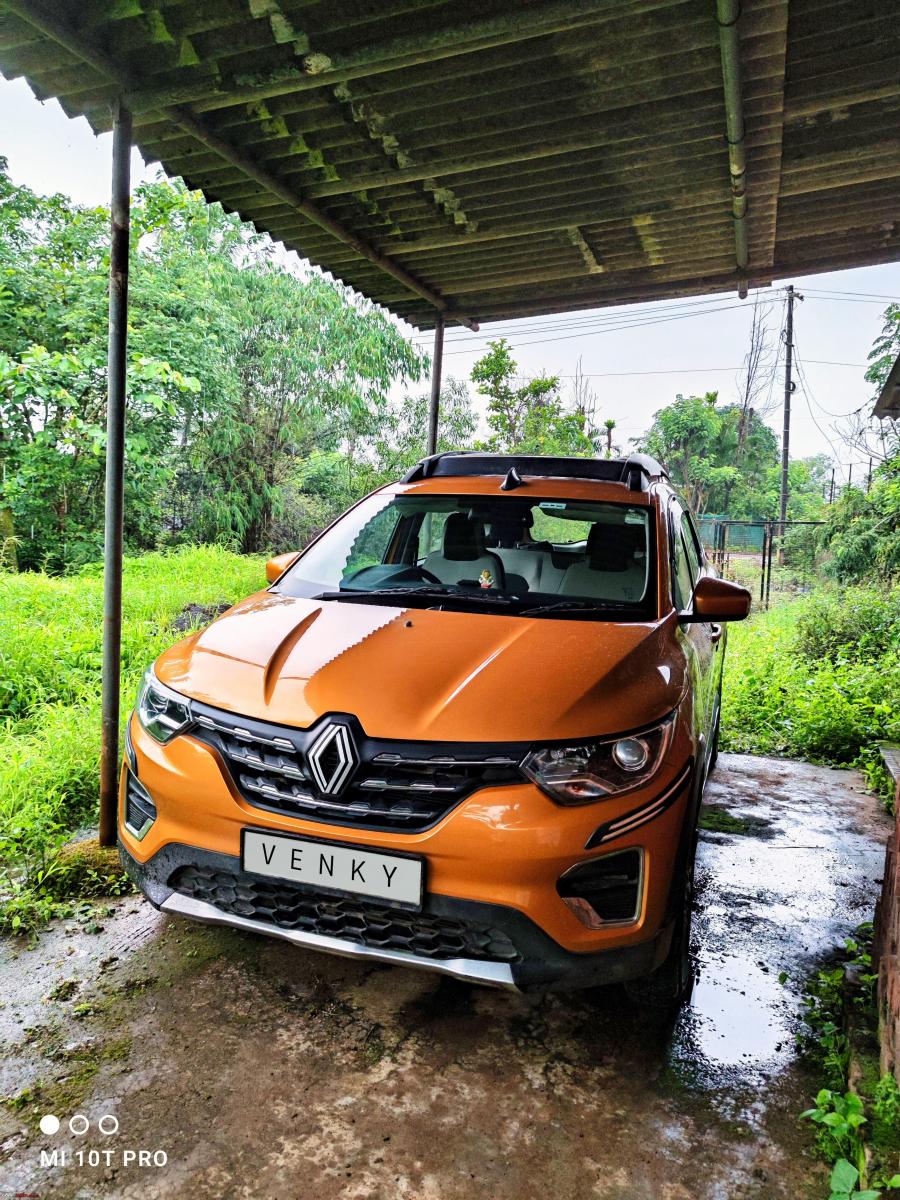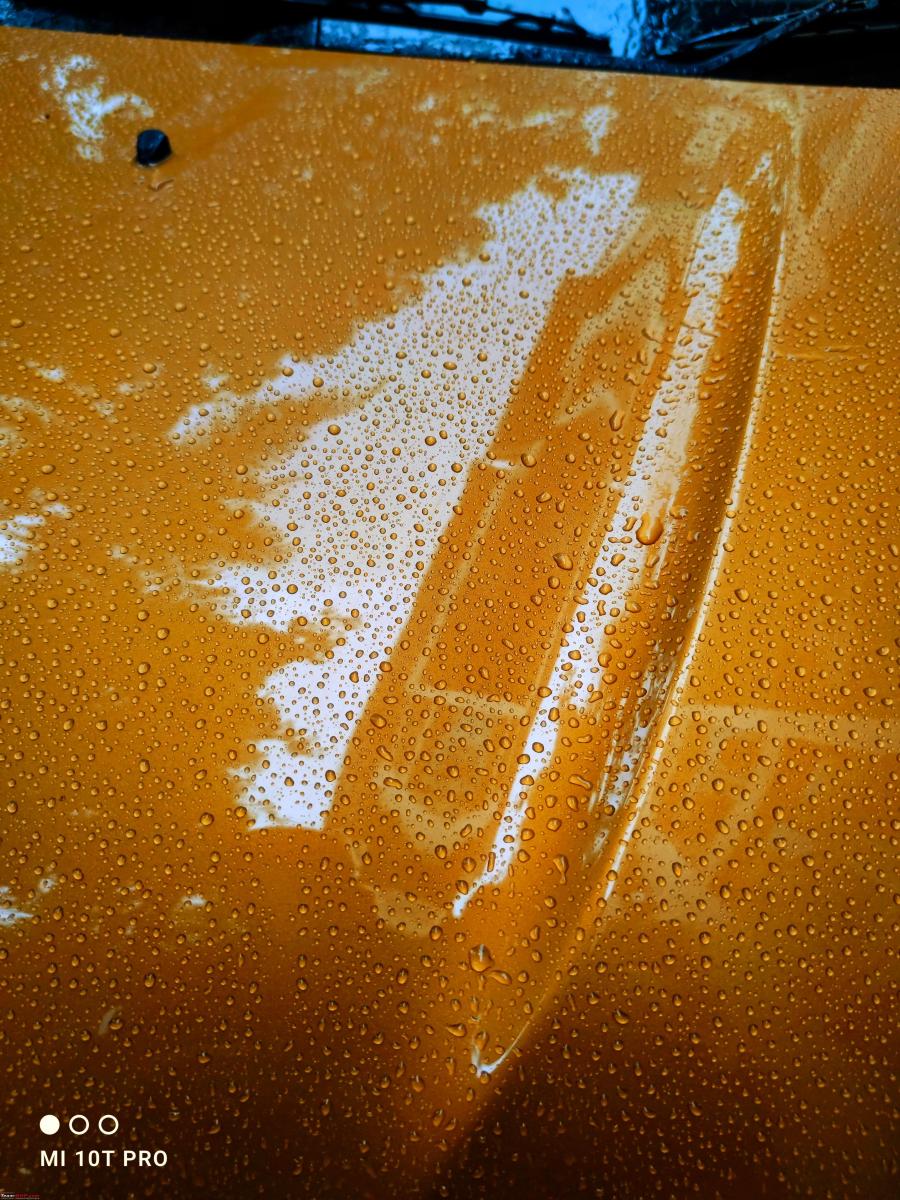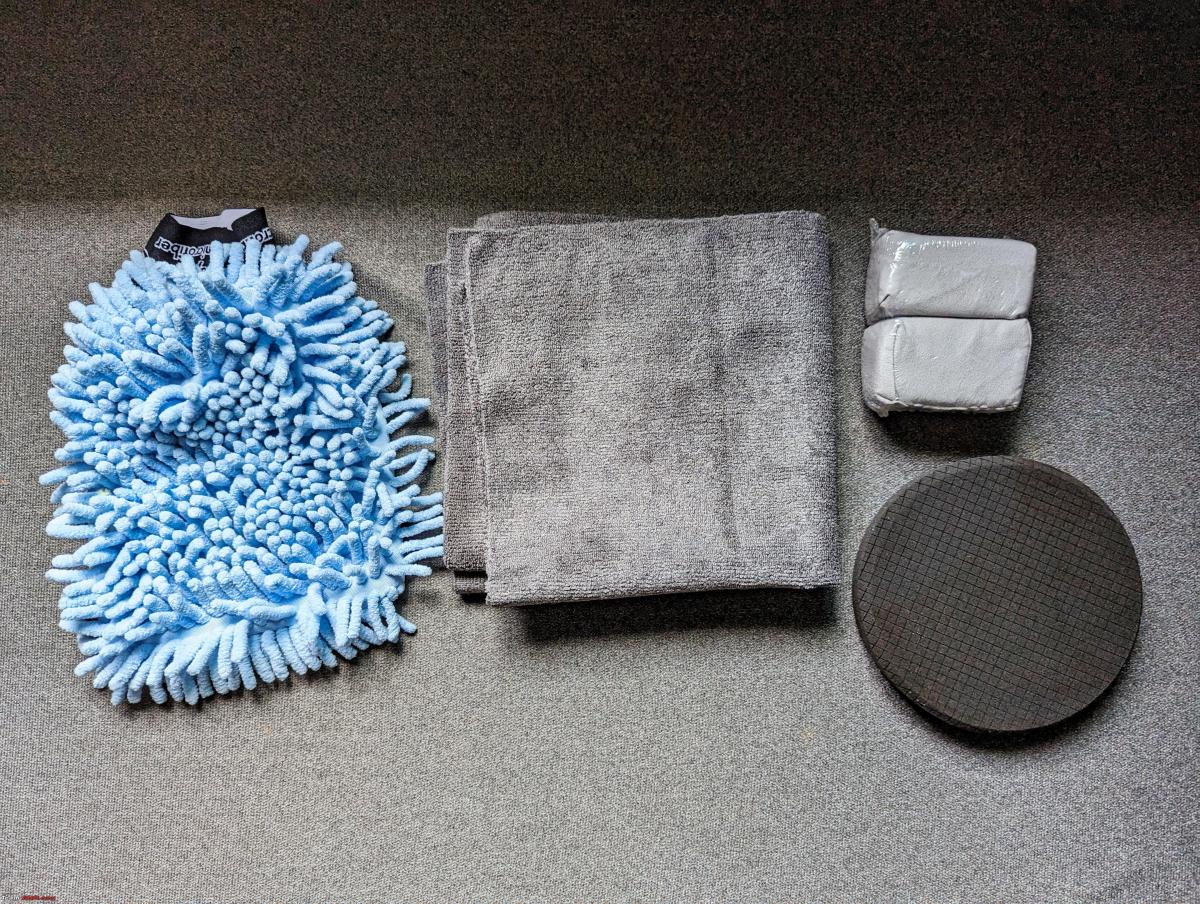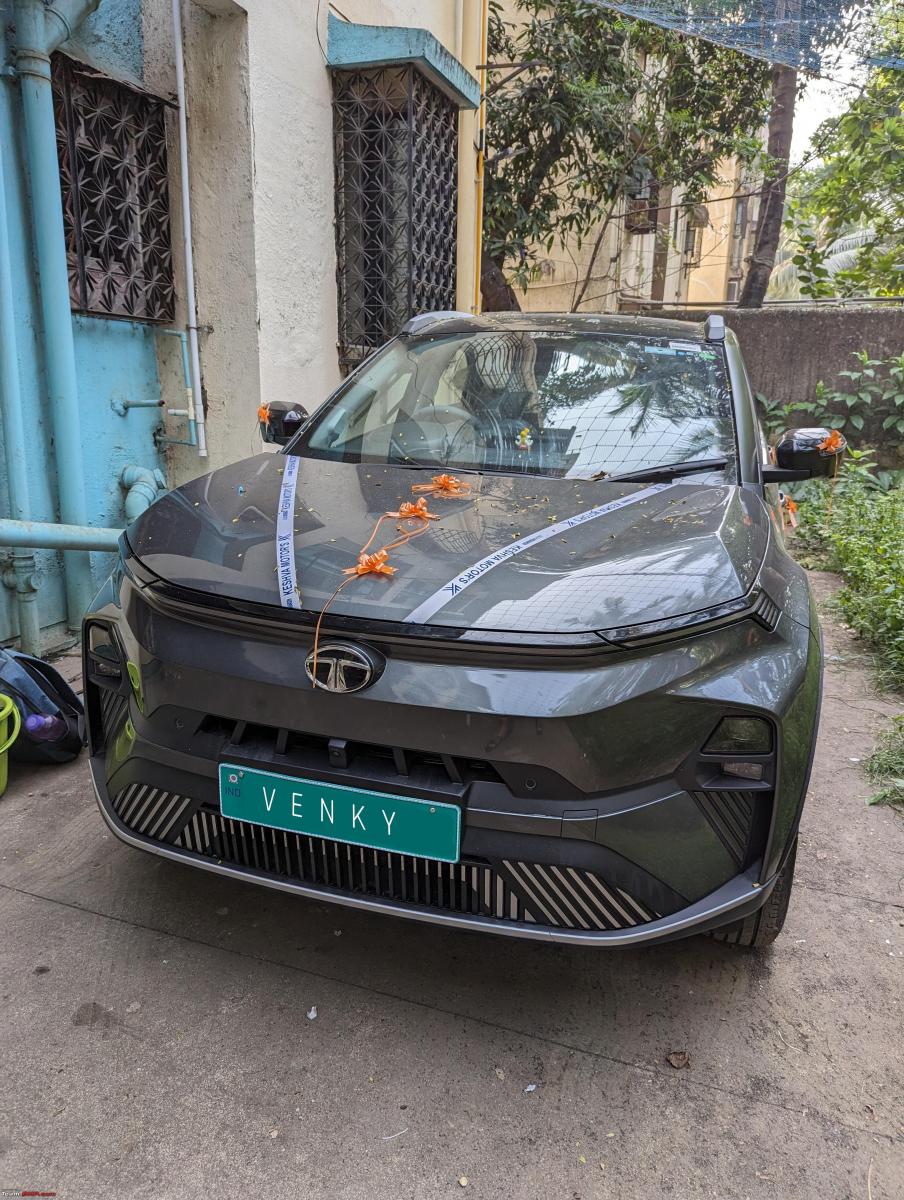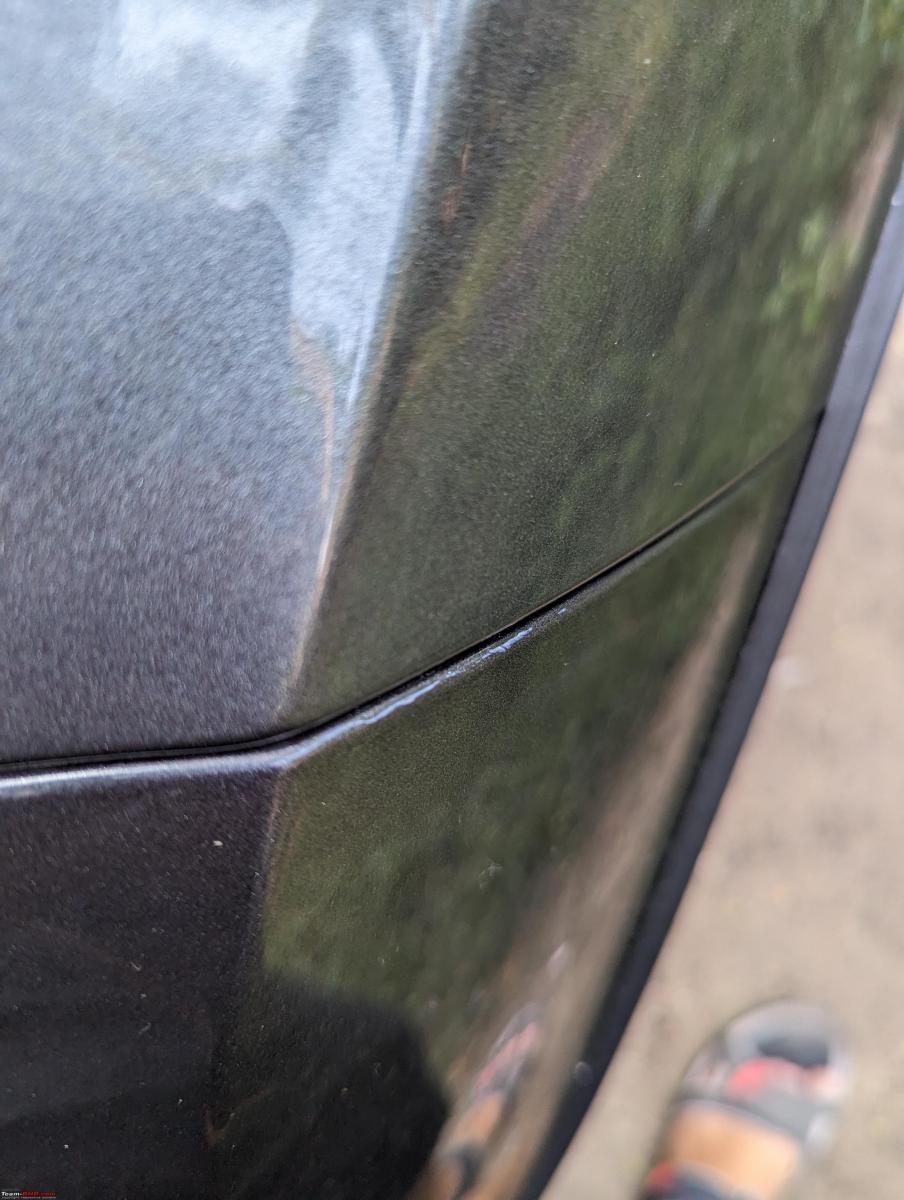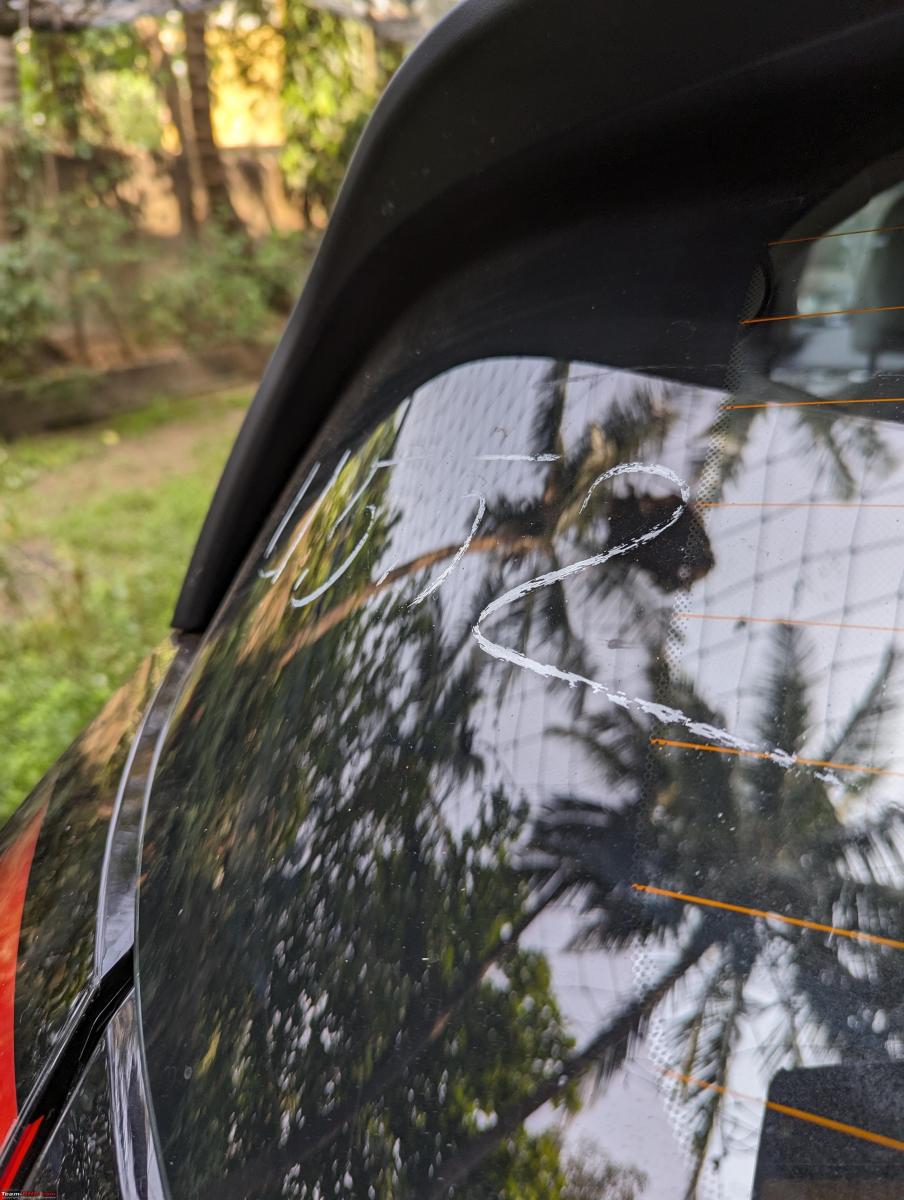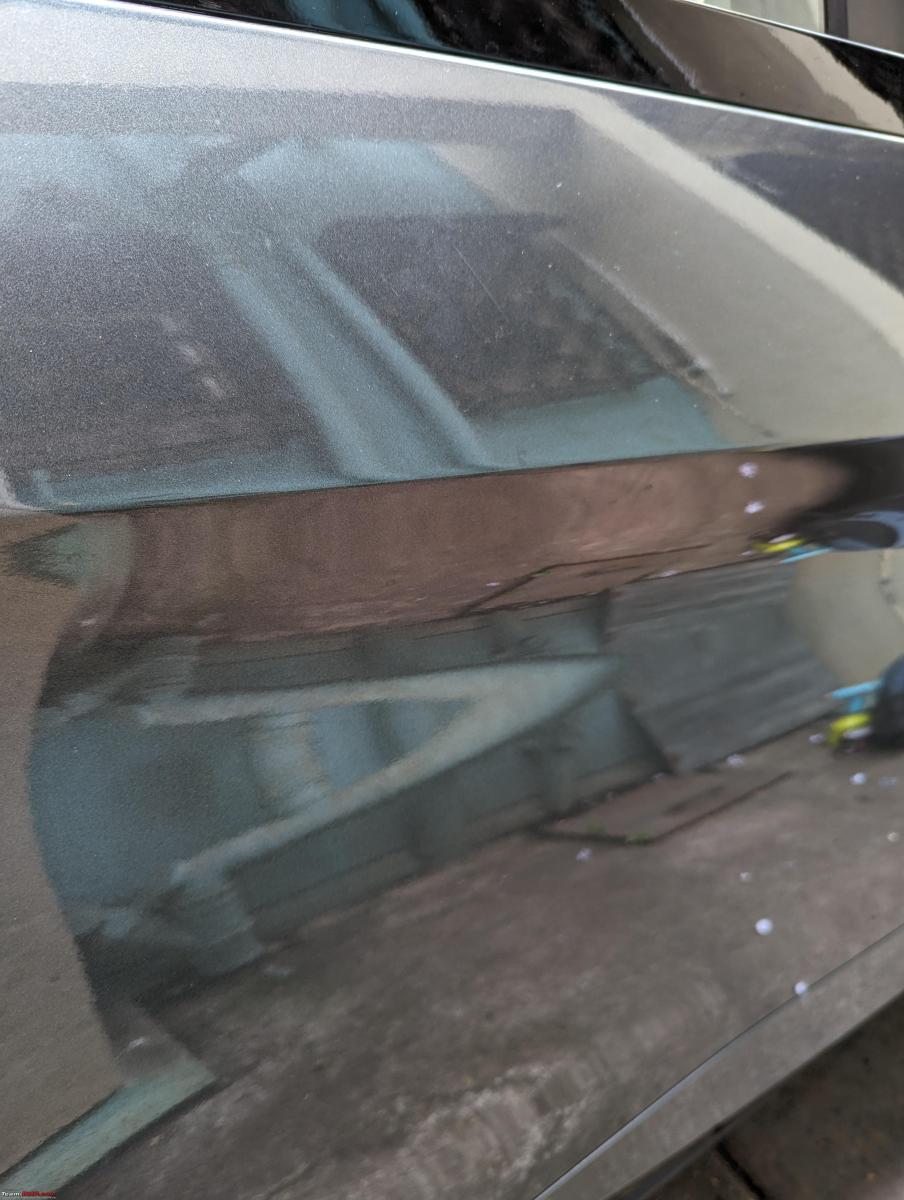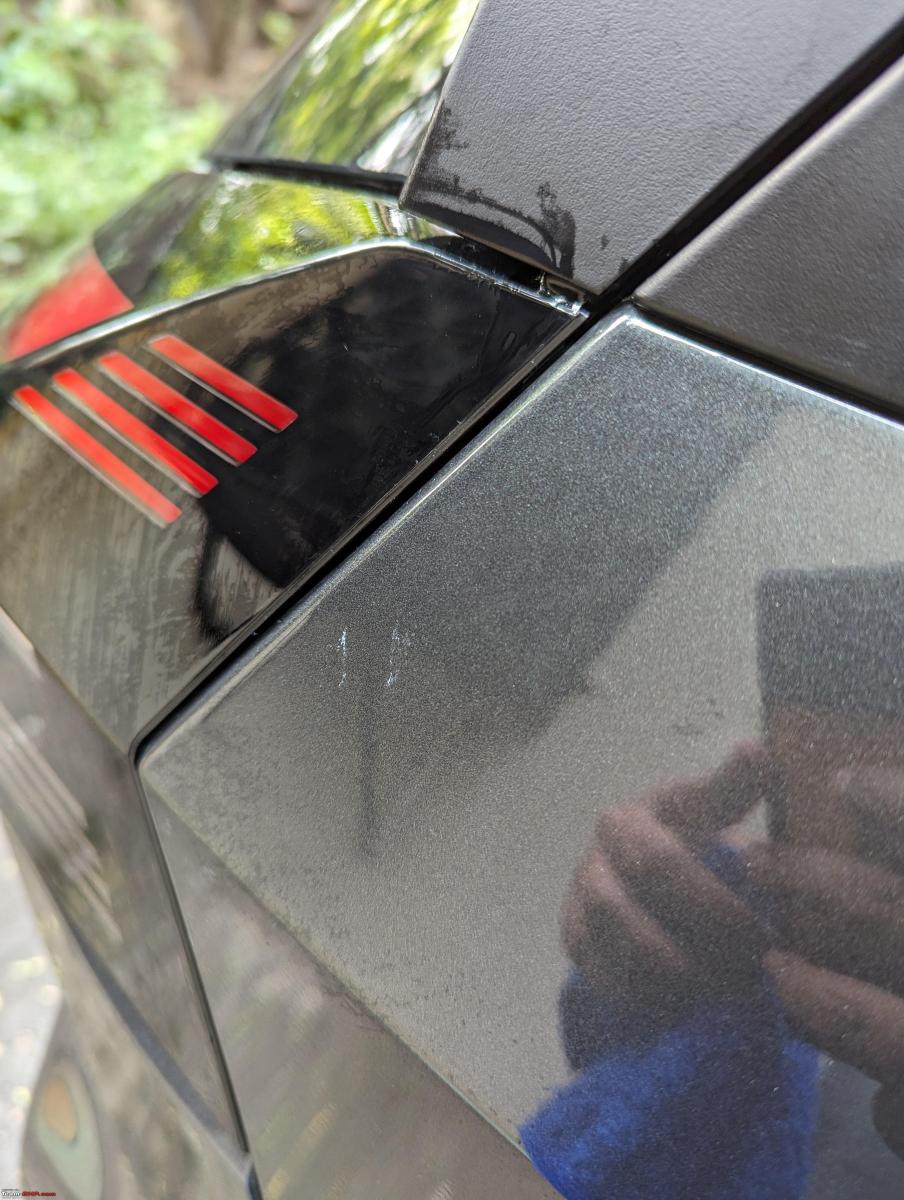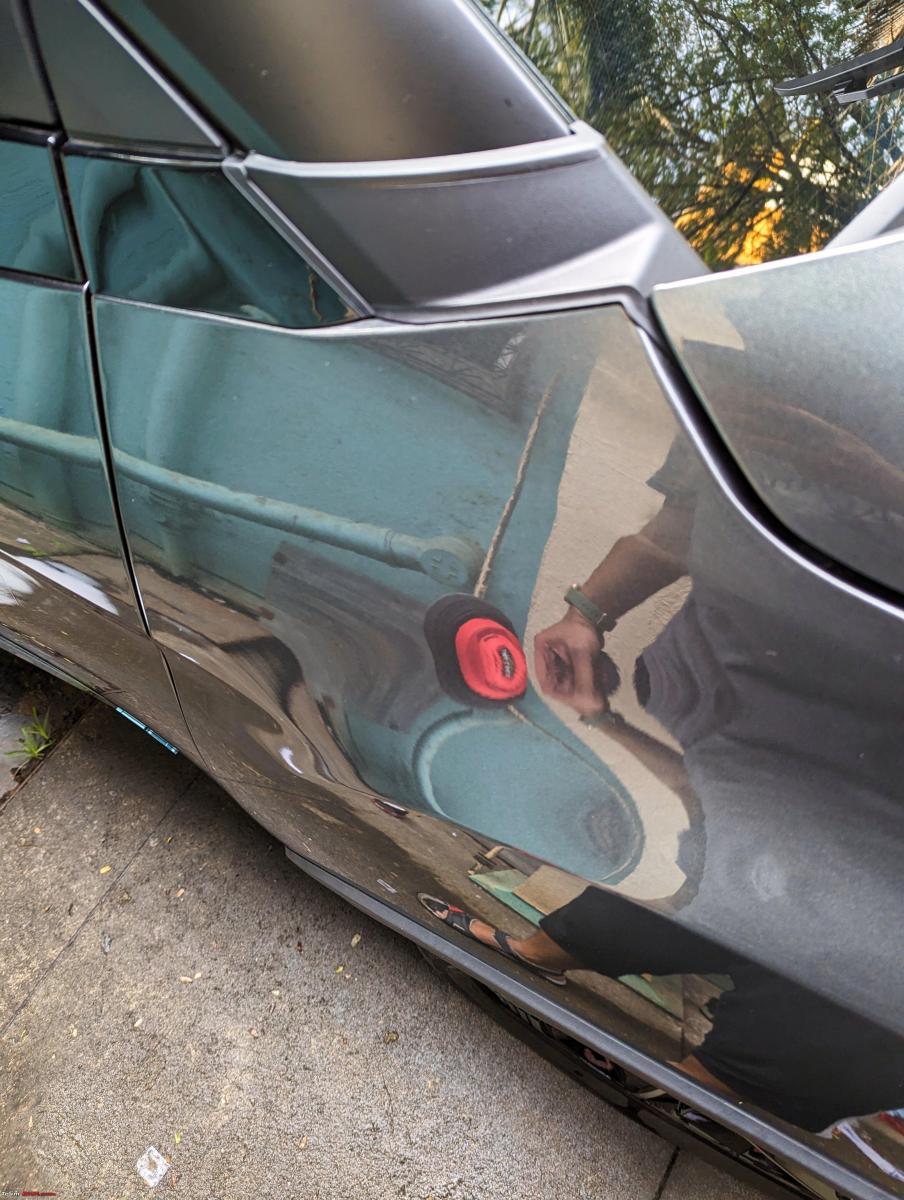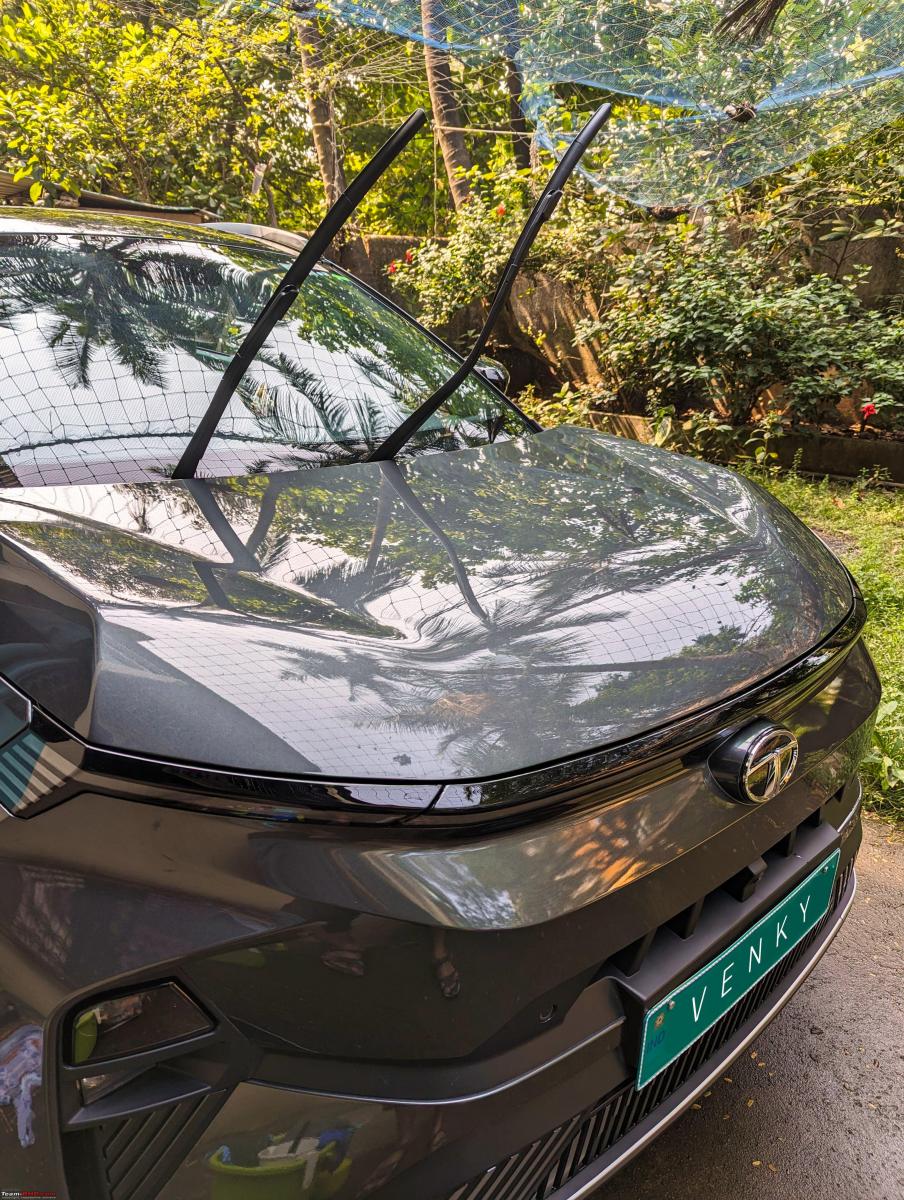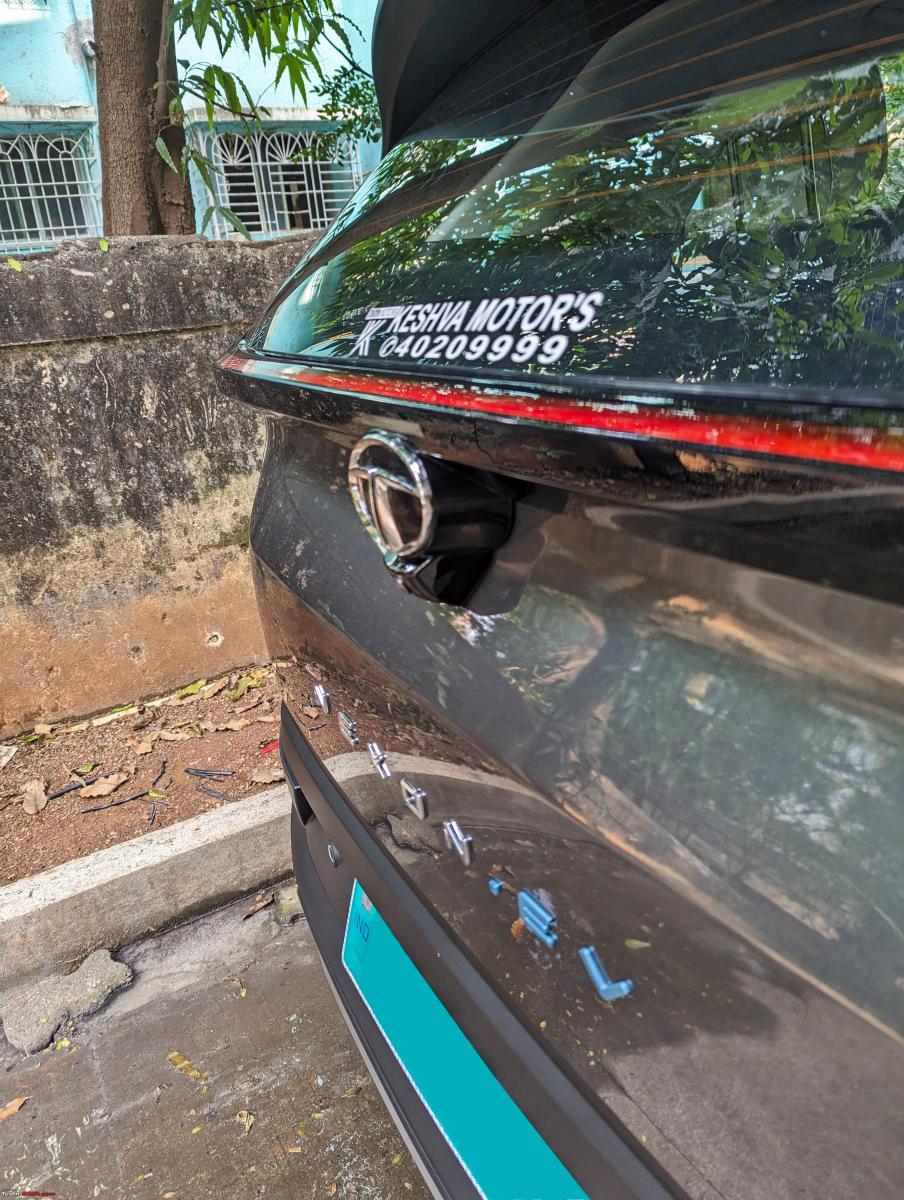Typically, compounding occurs before polishing, but I skipped compounding since heavy paint correction was not required.
BHPian Venky recently shared this with other enthusiasts.
Why Ceramic?
The debate between ceramic coating and PPF has been ongoing for quite some time, with each option presenting its own set of pros and cons. However, I had two significant concerns that held me back from opting for PPF:
- Taking apart a new car panel by panel.
- The price : ₹1 lakh + gst for Garware film + labour charges.
This left me with 2 options, sealants and ceramic coatings. I’ve had a great experience with TurtleWax Seal N Shine. It was easy to work with, required minimal prep, and lasted a solid 4-6 months(highly recommended). Sharing a shot of my Triber after 2.5 years with Seal N Shine applied every 4-6 months:
I decided to step up my protection game by opting for ceramic coating. It’s important to note that coatings aren’t magic; they’re a crucial part of protection, but the overall effectiveness hinges on how you maintain and clean your car. Sealants are perfect for beginners because most of them don’t require any time to cure and are very easy to work with.
Many detailers offer ceramic coating services, and their prices vary from ₹6,000 to ₹50,000. Some packages include maintenance coats every year for 3-5 years. I checked with 4-5 detailers, and when I asked about the brand of ceramic coating they use, most didn’t say, and a few mentioned local brands. When I asked more about how they prepare the paint before applying the ceramic coating, I didn’t get any satisfactory answers. I received promo videos on WhatsApp showing detailers using heavy cut wool pads and compounds on new cars with rotary polishers. This made me even more hesitant and discouraged about the whole process. After I began asking questions, many of the detailers who were previously calling me 2-3 times a day to schedule an appointment stopped contacting me. While some detailers seemed professional, there were significant extra expenses involved in getting the glass surfaces, alloys, and trim coated, the total was well above ₹50,000. I opted for the DIY route because it allowed me to tailor the process based on the actual condition of the paint. Additionally, I could choose specific products for each step according to my preferences.
Products Used:
Wavex Strip Wash Shampoo – Getting a good-quality strip wash shampoo is crucial because dealers often apply a significant amount of diluted silicone emulsion on trim and paint during delivery for visual appeal. A strip shampoo helps remove these temporary coatings/residues, allowing the ceramic coat to bond more effectively with the clear coat. Some people also use dishwash soaps or degreasers for this step. Went with wavex because I had used their degreaser earlier and it worked well.
Gyeon Q2M Prep – This is used after polishing step, it gets rid of all the oils and residue left by polish that you use. I purchased it with the coating, so went with the same brand.
Gyeon Cancoat EVO – Star of the show, I had shortlisted Cancoat EVO along with CarPro CQuartz Lite. But I could not source CQuartz Lite from any reputable source. Cancoat was next in line, with almost no flash time and the ability to be applied on all the exterior surfaces except windshield.
Wavex Iron & Fallout Remover – Used to decontaminate the paint from tiny iron particles. While considering alternatives, such as Autobros, I ultimately chose Wavex. Though international brands like Carpro offer similar products, their prices are considerably high.
Meguiars Ultimate Polish – Without a doubt, it’s the best polish I’ve ever used. It comes in a liquid-like consistency, making it easy to apply and doesn’t dry out quickly on the paint surface. A single bottle lasts a long time, and the pricing is reasonable.
Wavex Detailing Clay Bar – I preferred not to purchase the generic blue bars, and the choices from international brands were unreasonably expensive.
TurtleWax HS Ceramic Inside Job – AIO solution to clean, condition and protect. Easy to use and does not make the surface sticky.
Sonax Interior Cleaner – It wasn’t mandatory, but I chose to include it to tackle any stubborn stains.
Microfiber Wash Mitt – I prefer a wash mitt over a sponge because it’s easier to reach into all nooks and crannies.
Edgeless Microfiber 340GSM – I’ve been using Softspun’s microfiber cloths for several years now. This time, I purchased the edgeless ones specifically for wiping off the coating. Additionally, I have two other 550GSM towels for drying the car.
Wavex Suede Applicators – To prevent the foam from soaking in the product, they include a plastic liner between the foam and suede cloth in their design.
JPT 6 inch Black Pad – Opted for a low-cut pad, assuming that the new paint didn’t require heavy correction.
Electric sprayer – I used it to spray clay lube, emphasizing the importance of having both the clear coat and clay bar lubricated to prevent unnecessary marring of the paint surface.
JPT Cordless DA Polisher – Each battery provides approximately 50 minutes of usage, making it very convenient for weekend warriors like me. It’s also noticeably lighter compared to the cheaper rotary polishers found online, and it comes with a 6-inch backing plate.
The Process:
Step 1 : Wash The Car:
I started by removing all the ribbons and tape, then proceeded to wash with strip shampoo. In the photo, you can clearly see the glaze sprayed on the front grille. Cleaning it thoroughly is crucial to ensure the coating bonds effectively.
I apologize in advance for not documenting every step with photos; we were racing against time with the sun.
Step 2 : Inspect
Carefully inspect each panel, one by one, and be on the lookout for any imperfections. In my case, I was addressing relatively minor imperfections, and I’ve labeled the steps in which these were rectified.
Crayon marking(?)[Claying]
Sticker residue [Claying]
White crusty residue (I’m not sure what it was, but it was also present during the PDI, so I assume it might be factory compound residue.)[Claying]
Crayon marking(?)[Claying]
Light scratch [Polishing]
Sticker residue.
Step 3 : Spray Iron Fallout Remover
This step should take place before claying since claying cannot effectively eliminate iron contamination deeply embedded in clear coat pores. The liquid turns purple upon coming in contact with iron particles, and while I didn’t observe this color change on any of the paint surfaces, it did turn purple when sprayed on both front wheels.(Do not let the iron remover dry on paint.)
Step 4 : Wash The Car
I washed the car once again with strip shampoo to ensure complete removal of the iron remover from all surfaces where it was applied.
Step 5 : Claying
Note – Normally, step 5 would involve spraying the car with bug and tar remover, but I skipped this step as there was no need for it.
It’s crucial to focus on the panels and areas where you can genuinely feel surface contamination(Use the plastic-bag technique or simply run your fingers across the paint surface, and you’ll know). There’s no necessity to clay every inch of the paint, especially on a new car.
To prepare the clay lube, I used a mixture of strip shampoo and water, it was three times more concentrated than the recommended dilution for car wash.
When claying, start with a clean surface on the clay bar. Spray clay lube on both the clay bar and the paint surface, then glide it in a criss-cross pattern.(Don’t use a circular motion.)
Step 6 : Wash With Water
Water is enough to remove the clay lube residue.
Step 7 : Polishing
Note – Typically, compounding occurs before polishing, but I skipped compounding since heavy paint correction was not required.
I opted for a low-cut black pad for this step as I was aiming for very light paint correction. This essentially involves a two-step process: first, you prime the pad and paint surface at low speeds, and once the target section is properly primed with polish, increase the speed to begin the actual correction. It was my first time using a polisher, and I was somewhat anxious before starting, but everything went smoothly, and I didn’t encounter any issues with polish splatter. I even wore 3M safety glasses in anticipation of splatter, but with the correct technique and the right amount of polish, it was not a problem. (Mask the trim or at least ensure that polish is kept away from it.)
This was the last panel I polished :
Step 8 : IPA Wipe
A crucial step: I sprayed Gyeon Q2 Prep on all the surfaces intended for coating, allowed it to sit for a few seconds, and then wiped it off.
Step 9 : Ceramic Coating
I asked a friend to help with the last step to make things faster.
My friend and I followed these steps: I sprayed the coating on a suede applicator and applied it to the surface in a criss-cross pattern. Meanwhile, my friend had two microfibers, one for the initial wipe-off and another for the final finish. Since the coating had an instant flash time, there was no need for guessing or observation; the coating was wiped off as soon as I finished a particular section. During this step, I coated all the paint surfaces, trim surfaces, side door windows, mirrors, lights and all the alloys.
Covering the entire car took around 50 minutes, and we repeated the same steps for a second coat, applying a total of two coats. (You don’t require a substantial amount of product; applying more than necessary not only requires additional effort to remove the excess but also results in product wastage.)
I was genuinely pleased with the outcome. It’s a wonderful feeling to witness the results of our hard work. We stood there for a while, admiring the way the car looked.
Total Cost & Product Ratings :
Disclaimer: I am in no way associated with the brands mentioned, and all the products are purchased with my own money.
Wavex Strip Wash Shampoo:
Gyeon Q2M Prep:
- Had an amazing experience with the product, and even the sprayer was ergonomic, unlike the one that came with Wavex. However, it’s quite pricey at ₹1.7k.
- Rating – 4/5
- Cost – ₹1,689
Gyeon Cancoat EVO:
- It’s a complete kit in itself – the product comes in a metal bottle with three sprayers and a microfiber cloth. Absolutely worth it, as it significantly enhances the depth and gloss of the paint. It’s incredibly forgiving to work with, easily applying and coming off with instant flash time and quick cure time. It worked quite well on the trim too and didn’t leave any streaks or high spots on any surface.
- Rating – 5/5
- Cost – ₹4,771
Wavex Iron & Fallout Remover:
- It did the job, but the strong chemical smell made the experience very unpleasant. Will neither recommend nor buy it again.
- Rating – 2/5
- Cost – ₹620
Meguiars Ultimate Polish:
- It’s undoubtedly the best consumer-grade polish out there. I bought this bottle two years ago, and I believe it will easily last for another 1 or 2 years. The best part is that it doesn’t dry quickly, allowing you to cover large sections at a time, and it comes off without any drama. Can be applied by hand or with a machine.
- Rating – 5/5
- Cost – ₹800
Wavex Detailing Clay Bar:
- The product comes in a pack of 3, and the white clay makes it easier to spot trapped particles. It works as intended and doesn’t heavily mar the paint when used properly.
- Rating – 5/5
- Cost – ₹630
Microfiber Wash Mitt:
- A generic wash mitt, affordable and easy to work with.
- Rating – 5/5
- Cost – ₹376
Edgeless Microfiber 340GSM:
- No stickers and no edges to potentially scratch your paint surface, plus it’s affordable.
- Rating – 5/5
- Cost – ₹260
Wavex Suede Applicators:
- They were surprisingly effective; the soft foam made it easy to reach all surfaces. The plastic barrier between suede and foam was a bonus, preventing the foam from soaking up too much product and becoming saturated.
- Rating – 5/5
- Cost – ₹190
JPT 6 inch Black Pad
- Got it from the same brand as the polisher.
- Rating – 5/5
- Cost – ₹499
Electric sprayer:
- Not necessary, but decided to include it anyway to ensure that claying isn’t affected due to fatigue. Works as intended and battery lasts a long time.
- Rating – 4/5
- Cost – ₹1299
JPT Cordless DA Polisher:
- To be honest, I was initially skeptical about this product due to negative reviews regarding poor performance and missing charger. However, after watching reviews on YouTube that offered contrasting views, I decided to give it a try. It turned out to be a VFM purchase as I got it for ₹4k, and it’s an actual dual-action polisher. I was able to polish the entire car with just a single battery.
- Rating – 5/5
- Cost – ₹3999
Total (Consumables) : ₹9,050
Total (Everything else) : ₹6,623
Final Total : ₹15,673
Note : This does not include interior products as we decided to call it a day after completing the exterior work. I will provide updates in a later post.
Working on my car is therapeutic for me. At the end of the day, no one cares for your car more than you do & from my post, you can see that the actual supplies needed for one car are quite minimal. When you hire a detailer, a significant part of the cost goes towards paint correction and following the correct process, which comes from knowledge and experience.
To wrap it up, here’s to your next automotive adventure! I hope this post equips you with the knowledge to make wise decisions and pose the right questions when it comes to caring for your car. Until next time, happy detailing!
Check out BHPian comments for more insights and information.
Source: Read Full Article
